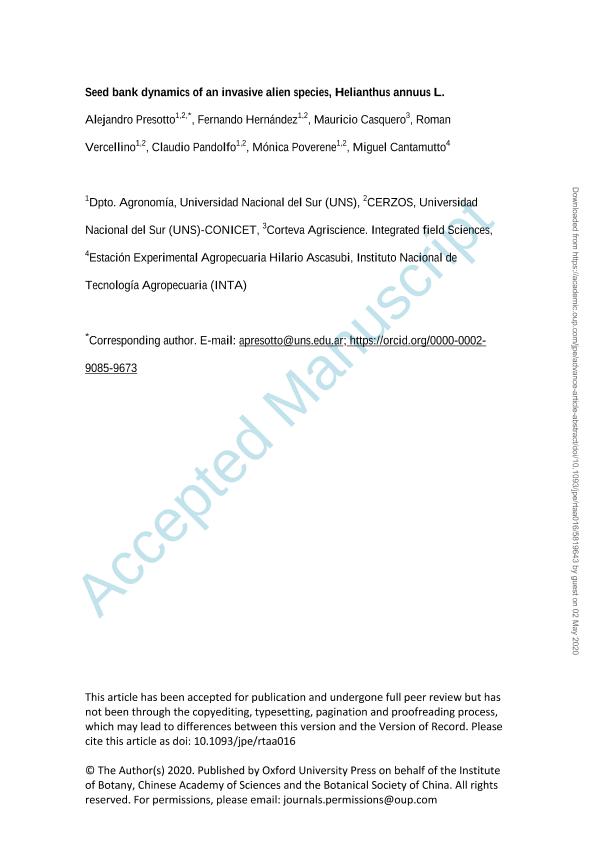Mostrar el registro sencillo del ítem
dc.contributor.author
Presotto, Alejandro Daniel

dc.contributor.author
Hernández, Fernando

dc.contributor.author
Casquero, Mauricio Javier

dc.contributor.author
Vercellino, Román Boris

dc.contributor.author
Pandolfo, Claudio Ezequiel

dc.contributor.author
Poverene, María Mónica

dc.contributor.author
Cantamutto, Miguel Ángel

dc.date.available
2020-07-08T14:24:06Z
dc.date.issued
2020-06
dc.identifier.citation
Presotto, Alejandro Daniel; Hernández, Fernando; Casquero, Mauricio Javier; Vercellino, Román Boris; Pandolfo, Claudio Ezequiel; et al.; Seed bank dynamics of an invasive alien species, Helianthus annuus L; Oxford Academic; Journal of Plant Ecology; 13; 3; 6-2020; 313–322
dc.identifier.issn
1752-993X
dc.identifier.uri
http://hdl.handle.net/11336/109084
dc.description.abstract
AimsThe ability to form persistent seed banks is one of the best predictors of species´ potential to establish in new ranges. Wild sunflower is native to North America where the formation of persistent seed banks is promoted by disturbance and it plays a key role on the establishment and persistence of native populations. However, the role of the seed banks on the establishment and persistence of invasive populations has not been studied. Here, we evaluated the role of seed bank and disturbance on the establishment and fitness, and seed persistence in the soil in several sunflower biotypes collected in ruderal (wild H. annuus) and agrestal (natural crop-wild hybrid) habitats of Argentina as well as volunteer populations (progeny of commercial cultivars).MethodsIn a seed-bank experiment, we evaluated emergence, survival to reproduction, survival of emerged seedlings, inflorescences per plant and per plot under disturbed and undisturbed conditions over two years; in a seed-burial experiment, we evaluated seed persistence in the soil over four springs (6, 18, 30 and 42 months).Important FindingsOverall, seedling emergence was early in the growing season (during winter), and it was promoted by disturbance, especially in the first year. Despite this, the number of inflorescences per plot was similar under both conditions, especially in ruderals. In the second year, emergence from the seed bank was much lower, but the survival rate was higher. In the seed-burial experiment, genetic differences were observed but seeds of ruderals and agrestals persisted up to 42 months while seeds of the volunteer did not persist longer than 6 months. The agrestal biotype showed an intermediate behavior between ruderals and volunteers in both experiments. Our findings showed that wild and crop-wild sunflower can form persistent seed banks outside its native range and that disturbance may facilitate its establishment in new areas.
dc.description.abstract
形成持久种子库的能力是预测物种在新区域成功建群的最佳指标之一。野生向日葵(Helianthus annuus L.)原产于北美,干扰促进了其种子库的形成,并对本地种群的建立和延续起着关键作用。然而,种子库在入侵种群的建立和延续中所起的作用尚不清楚。在本研究中,我们评估了种子库和干扰对几种向日葵生物类型(采集于阿根廷荒地生境中的野生向日葵、野生农田野生向日葵与作物向日葵自然杂交种,以及商业品种的后代)的建立和适应性,以及土壤中种子持久性的作用。在种子库试验中,我们评估了上述材料两年在干扰和未干扰条件下的出苗率、成活率到繁殖率、出苗成活率、每株花序数和每块地的花序数;在种子埋藏试验中,我们评估了其种子在四个春季(6个月、18 个月、30个月和42个月)土壤中的持久性。研究结果表明,总体而言,幼苗在生长期(冬季)出苗较早,且受到干扰促进,尤其是第一年。尽管如此,在两种情况下,每块样地的花序数是相近的,尤其是荒地生境中。第二年,种子库出苗率较低,但成活率较高。在种子掩埋实验中,观察到遗传差异,荒地和野生生境中种子持久性达到42个月,而商业品种后代的种子持久性不超过6个月。在这两项实验中,农田野生型和商业向日葵品种后代生物型表现出一种中间行为。结果表明,野生向日葵和作物野生向日葵杂交种均能在其生长范围之外形成持久的种子库,且干扰可能有助于其在新区域的建立。
dc.format
application/pdf
dc.language.iso
eng
dc.publisher
Oxford Academic
dc.rights
info:eu-repo/semantics/embargoedAccess
dc.rights.uri
https://creativecommons.org/licenses/by-nc-nd/2.5/ar/
dc.subject
SEED BANK
dc.subject
SEED PERSISTENCE
dc.subject
WILD SUNFLOWER
dc.subject
INVASIVE ALIEN SPECIES
dc.subject
RUDERAL
dc.subject
AGRESTAL
dc.subject.classification
Agronomía, reproducción y protección de plantas

dc.subject.classification
Agricultura, Silvicultura y Pesca

dc.subject.classification
CIENCIAS AGRÍCOLAS

dc.title
Seed bank dynamics of an invasive alien species, Helianthus annuus L
dc.type
info:eu-repo/semantics/article
dc.type
info:ar-repo/semantics/artículo
dc.type
info:eu-repo/semantics/publishedVersion
dc.date.updated
2020-06-22T14:08:25Z
dc.journal.volume
13
dc.journal.number
3
dc.journal.pagination
313–322
dc.journal.pais
Reino Unido

dc.journal.ciudad
Oxford
dc.description.fil
Fil: Presotto, Alejandro Daniel. Universidad Nacional del Sur. Departamento de Agronomía; Argentina. Consejo Nacional de Investigaciones Científicas y Técnicas. Centro Científico Tecnológico Conicet - Bahía Blanca. Centro de Recursos Naturales Renovables de la Zona Semiárida. Universidad Nacional del Sur. Centro de Recursos Naturales Renovables de la Zona Semiárida; Argentina
dc.description.fil
Fil: Hernández, Fernando. Universidad Nacional del Sur. Departamento de Agronomía; Argentina. Consejo Nacional de Investigaciones Científicas y Técnicas. Centro Científico Tecnológico Conicet - Bahía Blanca. Centro de Recursos Naturales Renovables de la Zona Semiárida. Universidad Nacional del Sur. Centro de Recursos Naturales Renovables de la Zona Semiárida; Argentina
dc.description.fil
Fil: Casquero, Mauricio Javier. Corteva Agriscience; Argentina
dc.description.fil
Fil: Vercellino, Román Boris. Consejo Nacional de Investigaciones Científicas y Técnicas. Centro Científico Tecnológico Conicet - Bahía Blanca. Centro de Recursos Naturales Renovables de la Zona Semiárida. Universidad Nacional del Sur. Centro de Recursos Naturales Renovables de la Zona Semiárida; Argentina. Universidad Nacional del Sur. Departamento de Agronomía; Argentina
dc.description.fil
Fil: Pandolfo, Claudio Ezequiel. Universidad Nacional del Sur. Departamento de Agronomía; Argentina. Consejo Nacional de Investigaciones Científicas y Técnicas. Centro Científico Tecnológico Conicet - Bahía Blanca. Centro de Recursos Naturales Renovables de la Zona Semiárida. Universidad Nacional del Sur. Centro de Recursos Naturales Renovables de la Zona Semiárida; Argentina
dc.description.fil
Fil: Poverene, María Mónica. Consejo Nacional de Investigaciones Científicas y Técnicas. Centro Científico Tecnológico Conicet - Bahía Blanca. Centro de Recursos Naturales Renovables de la Zona Semiárida. Universidad Nacional del Sur. Centro de Recursos Naturales Renovables de la Zona Semiárida; Argentina. Universidad Nacional del Sur. Departamento de Agronomía; Argentina
dc.description.fil
Fil: Cantamutto, Miguel Ángel. Instituto Nacional de Tecnología Agropecuaria. Centro Regional Buenos Aires Sur. Estación Experimental Agropecuaria Hilario Ascasubi; Argentina
dc.journal.title
Journal of Plant Ecology
dc.rights.embargoDate
2021-01-01
dc.relation.alternativeid
info:eu-repo/semantics/altIdentifier/url/https://academic.oup.com/jpe/advance-article/doi/10.1093/jpe/rtaa016/5819643
dc.relation.alternativeid
info:eu-repo/semantics/altIdentifier/doi/http://dx.doi.org/10.1093/jpe/rtaa016
Archivos asociados
